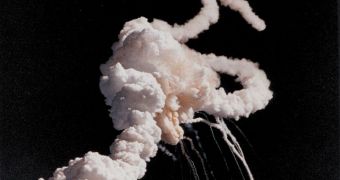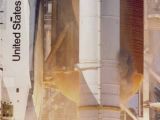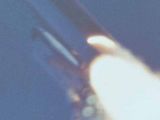Twenty two years ago, one of the most tragical aeronautical accidents in the history of mankind took place. After only 73 seconds into flight, the space shuttle Challenger suffered a catastrophic malfunction, leading to the disintegration of the vehicle and the death of its crew of seven.
Challenger was originally scheduled for launch from the Kennedy Space Center on January 22, at 2:43 p.m. local time, but, due to difficulties experienced with the previous mission STS-61-C, the liftoff of the space shuttle was delayed first for 23 January and then for 24 January. Bad weather and a malfunction to the hatch sensor imposed another two other delays, on 25 and 27 of January, and the mission was rescheduled for 28 of January.
The morning of 28 January was unusually cold, with temperatures reaching zero degrees Celsius, which was exactly the minimum temperature allowed for a safe liftoff. Several engineers from NASA revealed their concerns regarding the effects of the temperature on the O-ring sealing joints of the space shuttle's Solid Rocket Boosters. Furthermore, infrared camera observations on the region of the O-ring sealants revealed temperatures as low as -13 degrees Celsius, but this particular information had never reached the decision makers. After making a final inspection on the SRB's, Challenger was finally cleared for liftoff.
At 11:38:00 EST Challenger ignited its two SRB's and cleared the launchpad. However, the O-ring seal on the right SRB was not sealing the rocket completely and the increased pressure determined several metal components to bend away from each other, leaving gaps in the rocket through which gases at more than 2,760 degrees Celsius could escape. As a result, more than 70 percent of the O-ring was vaporized. The gap was temporarily closed by aluminum oxide propellant, before the flame actually penetrated the joint.
58 seconds after liftoff, NASA surface cameras observed flame originating from the attach strut of the right SRB, meaning that the aluminum oxide propellant sealant had been removed from its place by wind shear. Had it not happened, the SRB would have probably remained in place through the whole burning stage. Six seconds later the flame has changed shape severely, indicating that the external liquid fuel tank was penetrated and it was also leaking gas. The drop of pressure in the right SRB determined a unbalance in thrust, causing the onboard computer to pivot the nozzles of the space shuttle's main engines in order to compensate.
At an altitude of 14,6 kilometers into the Earth's atmosphere, only 73 seconds after liftoff, the right SRB detached from the lower strut and struck the external fuel tank of the space shuttle, which immediately disintegrated under the immense pressure of the hydrogen and oxygen fuel, causing Challenger to disintegrate as well.
The initial presumption was that the fuel tank had exploded, due to the massive fireball observed as Challenger disintegrated, but the investigation that followed after the disaster showed that, in fact, there had been only local signs of fuel combustion, and it's likely that the tank had just suffered a rapid disintegration.
Although the crew cabin detached soon after the incident and the astronauts had high chances of still being alive, the impact with the ocean surface, estimated to have taken place at about 334 kilometers per hour, would have generated a gravitational acceleration of more than 200 g, enough to kill the crew instantly and destroy the crew cabin.
Soon after NASA opened an internal investigation in order to determine the causes of the accident, but implied a secrecy strategy regarding the investigation highly criticized by the press which, in lack of information, turned to speculation suggesting that, in fact, the incident had been related to a malfunction in the external fuel tank.
The Roger Commission showed that the accident had been indeed caused by the O-ring's sensibility to low temperature, but most importantly due to failure to communicate, incomplete and misleading information, conflicts between engineers and NASA management and the existence of a managing structure that permitted some safety flight problems to be bypassed by bay shuttle engineers, ultimately resulting in the death of seven people: Michael J. Smith, Dick Scobee, Ronald McNair, Ellison Enizuka, Christa McAuliffe, Gregory Jarvis and Judith Resnik.

 14 DAY TRIAL //
14 DAY TRIAL // 

